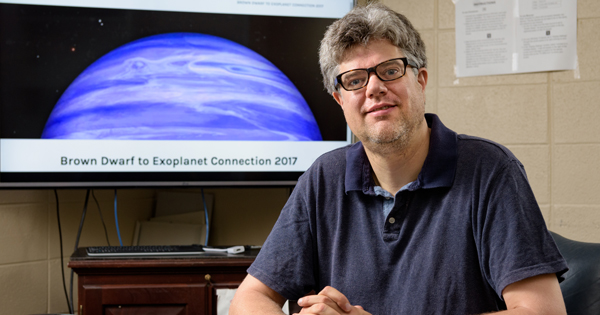


Failed stars fuel cosmic curiosity
Photo by Evan Krape October 25, 2017
UD astronomer John Gizis gives us a peek into brown dwarf stars
You might have had a favorite teddy bear or action figure when you were in first grade. But the night sky with its twinkling stars, bright planets and friendly-looking moon captured John Gizis’s fascination. And it still hasn’t loosened its hold. Today, Gizis, a professor of physics and astronomy at the University of Delaware, is an expert on brown dwarfs, which aren’t true stars or planets. He recently gave UDaily a peek into these curious celestial phenomena, and what scientists are learning from studying them.
Question: What exactly is a brown dwarf, and how did it get that name?
Answer: Brown dwarfs can be considered “failed stars.” They are not massive enough to sustain nuclear fusion and therefore get cooler and dimmer. Astronomers already used names like “white dwarf,” “red dwarf,” and “black hole,” so Jill Tarter, an American astronomer, suggested the name “brown dwarf.” They’re not literally brown, but the coolest ones might look something like Jupiter.
Q: Why do you study brown dwarfs?
A: I think brown dwarfs have the potential to challenge many of our concepts, because in some ways these are the smallest stars, but in other ways they seem like very massive planets. We can learn about how stars and planets form and also study planetary atmospheres.
Q: What’s your latest research tell us about these celestial phenomena?
A: My group has been looking at brown dwarfs with the Kepler space telescope to search for magnetic white light flares. We’ve found that even though young brown dwarfs are cooler and dimmer than the sun, they can actually generate more powerful flares than the sun does. However, the cooler brown dwarfs don’t seem to have these flares.
Q: What do you think living on a brown dwarf would be like?
A: Life on a brown dwarf is very speculative because there’s no surface and there’s no evidence life exists there. We can imagine creatures who float in the cool upper atmosphere, but they would constantly be in danger of being dragged down to the searing hot depths. It does seem likely that brown dwarfs could have planets orbiting them, but for them, we’d worry that the planets would start too hot and end up too cold as the brown dwarf itself cools off.
Q: You are chairing the 2017 Brown Dwarf to Exoplanet Connection Conference, held at UD, Oct. 26–27. What big topics will you discuss?
A: The biggest topic is how we can learn about the physics and chemistry of planetary atmospheres by studying brown dwarfs. For example, brown dwarfs were the first place astronomers observed weather clouds outside our solar system—but they were clouds made of minerals and iron, not water ice. Recently, water ice clouds were observed in the coolest known brown dwarf. We’re going to hear about the latest scientific studies on brown dwarfs and have brought in experts on Jupiter and Saturn and experts on exoplanets to think about the next steps we should take.
Q: Are there any new ‘search tools’ on the horizon for you and your colleagues?
A: We are all eager for the 2019 launch of NASA’s James Webb Space Telescope, which will enable the atmospheres of brown dwarfs and exoplanets to be studied in unprecedented detail. Soon after that, the National Science Foundation’s Large Synoptic Survey Telescope (LSST) in Chile will start continuously surveying the sky, bringing a new need for “big data science” experts in astronomy.
Q: Do you have the same sense of wonder now, as you did when you were a child, when you look at the nighttime sky?
A: I remember as far back as first grade I was in love with astronomy, and it seemed like NASA was announcing amazing new discoveries all the time. The Voyager probes were launched to visit all the outer planets. I am more amazed by the night sky than ever—though maybe that’s because growing up near New York City there was always a lot of light pollution.
Contact Us
Have a UDaily story idea?
Contact us at ocm@udel.edu
Members of the press
Contact us at 302-831-NEWS or visit the Media Relations website

